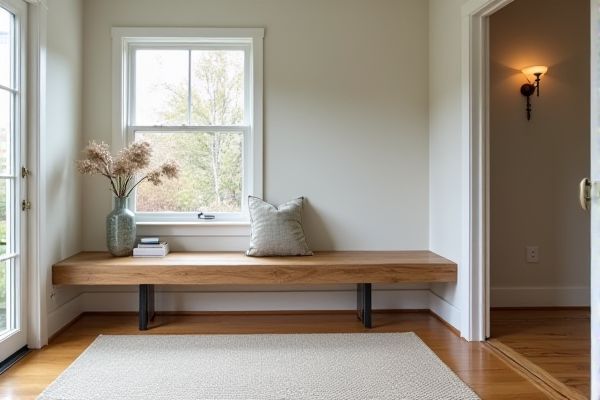
A built-in bench offers a seamless, space-saving design integrated directly into your room's structure, while a freestanding bench provides flexible placement and easy relocation options. Explore the advantages of each to determine which bench best fits your lifestyle and enhances your living space.
Table of Comparison
| Feature | Built-in Bench | Freestanding Bench |
|---|---|---|
| Installation | Permanent, integrated into structure | Movable, no permanent installation needed |
| Space Efficiency | Maximizes space, custom fit | Requires additional floor space |
| Design Flexibility | Limited to room layout, fixed style | Wide style and placement options |
| Portability | Non-portable | Portable and easy to move |
| Cost | Higher due to custom build | Generally lower, ready-made options |
| Durability | Often sturdier, built-in materials | Varies by material and build |
| Maintenance | Harder to repair or replace | Easy to clean and maintain |
Introduction to Built-In and Freestanding Benches
Built-in benches are integrated into your home's structure, offering a seamless, space-saving seating solution often customized to fit specific areas like window nooks or dining corners. Freestanding benches provide versatile, movable seating options that can be easily repositioned or used in multiple spaces, making them ideal for flexible room layouts. Choosing between built-in and freestanding benches depends on your space, style preferences, and functional needs.
Design Flexibility and Customization Options
Built-in benches offer seamless integration with surrounding architecture, allowing for tailored dimensions and materials that maximize space efficiency and create a cohesive design. Freestanding benches provide greater design flexibility, easily moved or replaced to adapt to changing decor or functional needs without permanent installation. Customization options vary, with built-in benches often requiring professional craftsmanship for bespoke finishes, while freestanding benches come in a wider range of styles and materials readily available for immediate use.
Space Efficiency and Room Layout
Built-in benches maximize space efficiency by fitting seamlessly into corners or under windows, making optimal use of otherwise unused areas in your room layout. Freestanding benches offer flexibility, allowing you to rearrange or relocate seating easily but may occupy more floor space and disrupt traffic flow. Consider your room's dimensions and functional needs to choose the option that best complements your space efficiency goals.
Installation Process and Complexity
Built-in benches require precise measurements and structural modifications, often involving framing, securing to walls or floors, and integration with existing architectural elements, which can make the installation process more complex and time-consuming. Freestanding benches offer a simpler installation, as they typically only need to be positioned in place without any permanent attachment or alteration to your space. Choosing between the two depends on your willingness to invest time and effort in installation versus the convenience of a ready-to-use seating option.
Durability and Longevity Comparison
Built-in benches typically offer greater durability due to their fixed installation, which provides enhanced stability and resistance to wear over time compared to freestanding benches. Freestanding benches, while more versatile and movable, often face increased risk of damage from frequent relocation and less secure anchoring. When choosing, consider your long-term usage needs, as built-in benches better withstand heavy use and environmental exposure, extending your seating investment's longevity.
Cost Considerations and Budgeting
Built-in benches typically involve higher upfront costs due to custom design, materials, and installation fees, making them a more significant investment compared to freestanding benches. Freestanding benches offer greater budget flexibility since they come in a wide range of prices and require no construction, allowing you to find options that suit your financial plan. Prioritizing your space requirements and long-term use will help determine which bench option aligns best with your overall budget considerations.
Maintenance and Cleaning Requirements
Built-in benches typically require less maintenance and cleaning because their fixed structure limits dirt buildup in hard-to-reach areas and they often feature materials tailored for durability. Freestanding benches need more frequent cleaning since they can accumulate dust and debris underneath and around the legs, demanding regular attention to maintain their appearance. Your choice should consider how much time you're willing to invest in upkeep based on these differing maintenance needs.
Mobility and Future Adaptability
Freestanding benches offer superior mobility, allowing users to easily rearrange or relocate seating to accommodate changing needs or room layouts. Built-in benches are fixed installations, limiting flexibility but providing a permanent and sturdy seating solution that maximizes space efficiency. Future adaptability favors freestanding benches as they can be repurposed or replaced without structural modifications.
Aesthetic Impact on Interior Design
Built-in benches create a seamless, integrated look that enhances the architectural flow and maximizes space efficiency, often becoming a focal point in interior design. Freestanding benches offer versatility and mobility, allowing you to adapt the layout and introduce varied styles or textures that complement your existing decor. Your choice between these options significantly influences the room's visual harmony and can either amplify or soften the overall aesthetic impact.
Choosing the Right Bench for Your Space
Built-in benches maximize space efficiency by integrating seamlessly into walls or corners, ideal for smaller rooms or custom layouts requiring permanent seating solutions. Freestanding benches offer greater flexibility and mobility, making them perfect for multi-purpose areas or when occasional seating is needed without permanent installation. Consider room size, layout, and intended use to select a bench that balances functionality with aesthetic appeal in your specific living space.
 homyna.com
homyna.com